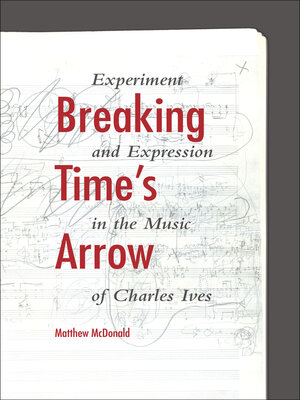Breaking Time's Arrow
ebook ∣ Experiment and Expression in the Music of Charles Ives
By Matthew McDonald

Sign up to save your library
With an OverDrive account, you can save your favorite libraries for at-a-glance information about availability. Find out more about OverDrive accounts.
Find this title in Libby, the library reading app by OverDrive.



Search for a digital library with this title
Title found at these libraries:
| Library Name | Distance |
|---|---|
| Loading... |
A critical look at the work of and philosophical influences upon the American Modernist composer.
Charles Ives (1874–1954) moved traditional compositional practice in new directions by incorporating modern and innovative techniques with nostalgic borrowings of 19th century American popular music and Protestant hymns. Matthew McDonald argues that the influence of Emerson and Thoreau on Ives's compositional style freed the composer from ordinary ideas of time and chronology, allowing him to recuperate the past as he reached for the musical unknown. McDonald links this concept of the multi-temporal in Ives's works to Transcendentalist understandings of eternity. His approach to Ives opens new avenues for inquiry into the composer's eclectic and complex style.
"A trenchant and intellectually expansive reading of Ives's relationship to time by connecting several compositions?and indeed, the composer's larger conceptualization of the past, present, and future?to the Emersonian concept of the "everlasting Now." This book is a wonderfully written, important contribution to scholarship on the music of Charles Ives." —Gayle Sherwood Magee, author of Charles Ives Reconsidered
"McDonald investigates both the temporal and spatial effects of multidirectional motion, as well as its ramifications for understanding some of the larger philosophical issues that are raised in Ives's music." —Music & Letters, May 2015
"McDonald brings together analytic and personal factors to sharpen the image of the composer in convincing ways. . . . This book . . . deserves a close reading. The bibliography provides a select list of scores and recordings as well as articles, books, catalogues, and unpublished commentaries. This book is recommended for college and university libraries and for readers with a music theory background." —Music Reference Services Quarterly
Charles Ives (1874–1954) moved traditional compositional practice in new directions by incorporating modern and innovative techniques with nostalgic borrowings of 19th century American popular music and Protestant hymns. Matthew McDonald argues that the influence of Emerson and Thoreau on Ives's compositional style freed the composer from ordinary ideas of time and chronology, allowing him to recuperate the past as he reached for the musical unknown. McDonald links this concept of the multi-temporal in Ives's works to Transcendentalist understandings of eternity. His approach to Ives opens new avenues for inquiry into the composer's eclectic and complex style.
"A trenchant and intellectually expansive reading of Ives's relationship to time by connecting several compositions?and indeed, the composer's larger conceptualization of the past, present, and future?to the Emersonian concept of the "everlasting Now." This book is a wonderfully written, important contribution to scholarship on the music of Charles Ives." —Gayle Sherwood Magee, author of Charles Ives Reconsidered
"McDonald investigates both the temporal and spatial effects of multidirectional motion, as well as its ramifications for understanding some of the larger philosophical issues that are raised in Ives's music." —Music & Letters, May 2015
"McDonald brings together analytic and personal factors to sharpen the image of the composer in convincing ways. . . . This book . . . deserves a close reading. The bibliography provides a select list of scores and recordings as well as articles, books, catalogues, and unpublished commentaries. This book is recommended for college and university libraries and for readers with a music theory background." —Music Reference Services Quarterly







